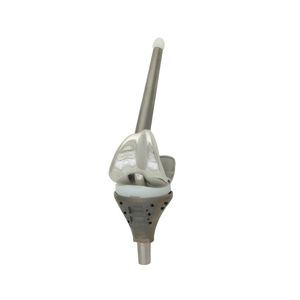
- Products
- Catalogs
- News & Trends
- Exhibitions
Primary hip prosthesis cementless
Add to favorites
Compare this product
Characteristics
- Surgical application
- primary
- Fixation type
- cementless
Description
Lightweight Materials:
Use advanced materials like titanium alloys or carbon-fiber composites to minimize weight while ensuring strength and durability.
Compatibility:
Design the prosthesis to have standardized interfaces for seamless integration with various femoral head or acetabular prostheses, allowing for customization based on patient anatomy.
Tendon Suturing Pores:
Integrate strategically placed suturing pores on the prosthesis, especially around the greater and lesser trochanters. These pores should be designed to allow for secure tendon attachment, promoting muscle function and improving overall mobility.
Muscle Function Restoration:
Implement anatomical contours that mimic natural bone structure to facilitate muscle attachment and leverage. This design should enhance biomechanical performance, enabling better movement and load distribution.
Taper Locking Assembly:
Incorporate a taper locking mechanism for a strong and reliable bond between components. This feature will ensure a secure fit that can withstand the dynamic loads experienced during daily activities.
Surface Treatments:
Utilize bioactive coatings or surface texturing to promote osseointegration, ensuring that the prosthesis bonds effectively with surrounding bone tissue over time.
Modular Design:
Consider a modular approach that allows for easy adjustments or replacements of components without needing to replace the entire prosthesis, accommodating future revisions if necessary.
Radiolucent Features:
Design components with radiolucent materials in non-load-bearing areas to facilitate post-operative imaging without interference, aiding in monitoring healing progress.
Catalogs
No catalogs are available for this product.
See all of EgiFix‘s catalogsExhibitions
Meet this supplier at the following exhibition(s):

Related Searches
- Bone plate
- Compression plate
- Metallic compression plate
- Locking compression plate
- Titanium compression plate
- Distal compression plate
- Compression bone screw
- Interbody fusion cage
- Metallic compression bone screw
- Proximal compression plate
- Mid-shaft compression plate
- Forearm compression plate
- Arthrodesis nail
- Lateral compression plate
- Tibia compression plate
- Femoral stem
- PEEK interbody fusion cage
- General purpose compression bone screw
- Metallic intramedullary nail
- Humerus compression plate
*Prices are pre-tax. They exclude delivery charges and customs duties and do not include additional charges for installation or activation options. Prices are indicative only and may vary by country, with changes to the cost of raw materials and exchange rates.



